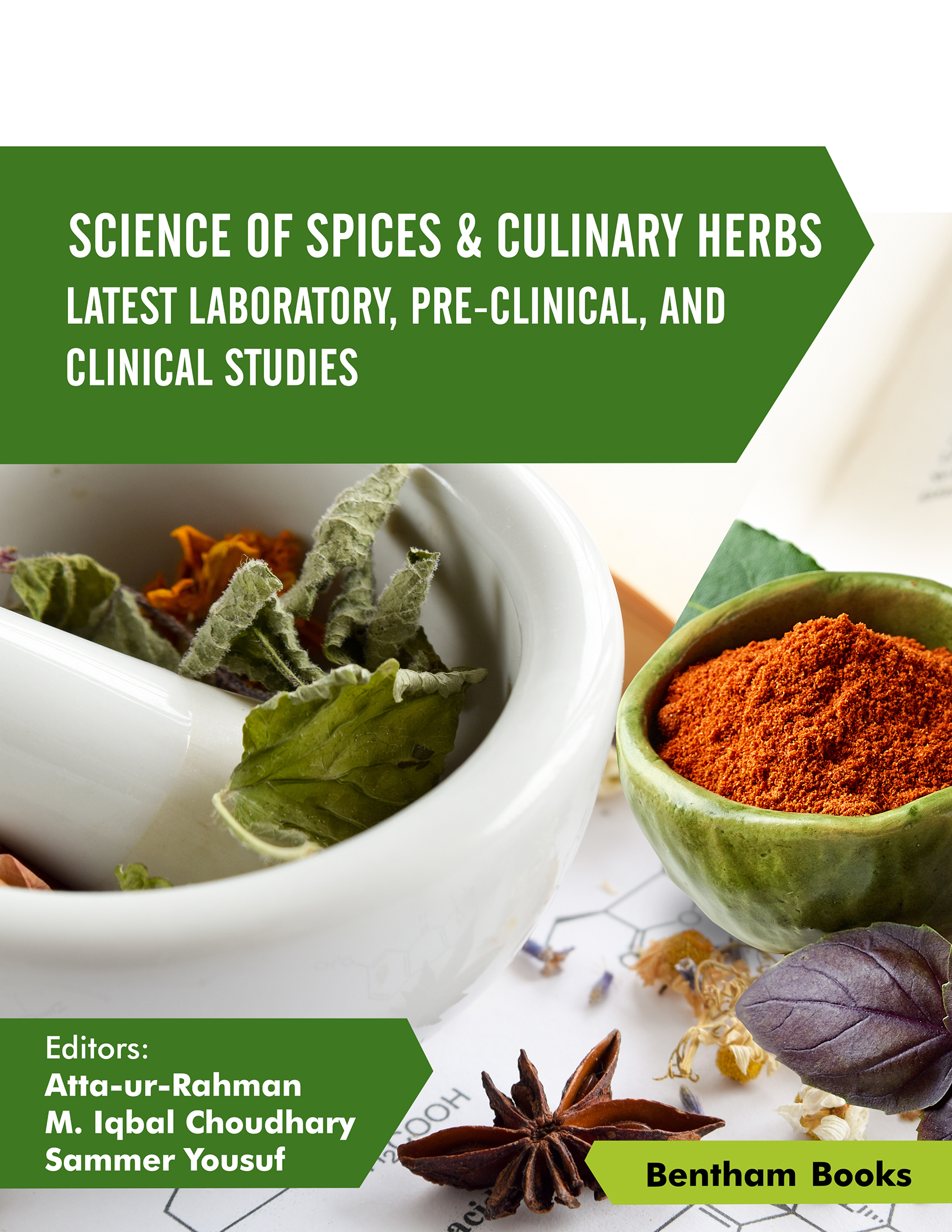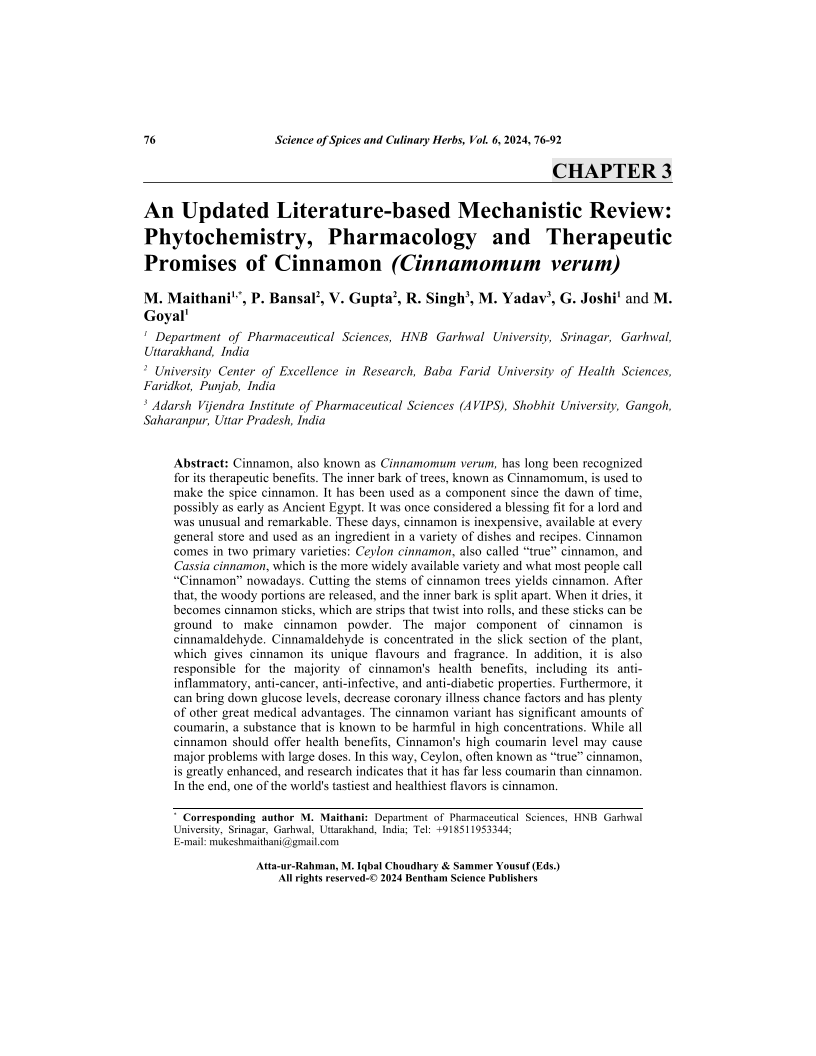- Home
- Books
- Science of Spices and Culinary Herbs - Latest Laboratory, Pre-clinical, and Clinical Studies: Volume 6
- Chapter
An Updated Literature-based Mechanistic Review: Phytochemistry, Pharmacology and Therapeutic Promises of Cinnamon (Cinnamomum verum)

- Authors: M. Maithani1, P. Bansal2, V. Gupta3, R. Singh4, M. Yadav5, G. Joshi6, M. Goyal7
-
View Affiliations Hide AffiliationsAffiliations: 1 Department of Pharmaceutical Sciences, HNB Garhwal University, Srinagar, Garhwal, Uttarakhand, India 2 University Center of Excellence in Research, Baba Farid University of Health Sciences, Faridkot, Punjab, India 3 University Center of Excellence in Research, Baba Farid University of Health Sciences, Faridkot, Punjab, India 4 Adarsh Vijendra Institute of Pharmaceutical Sciences (AVIPS), Shobhit University, Gangoh, Saharanpur, Uttar Pradesh, India 5 Adarsh Vijendra Institute of Pharmaceutical Sciences (AVIPS), Shobhit University, Gangoh, Saharanpur, Uttar Pradesh, India 6 Department of Pharmaceutical Sciences, HNB Garhwal University, Srinagar, Garhwal, Uttarakhand, India 7 Department of Pharmaceutical Sciences, HNB Garhwal University, Srinagar, Garhwal, Uttarakhand, India
- Source: Science of Spices and Culinary Herbs - Latest Laboratory, Pre-clinical, and Clinical Studies: Volume 6 , pp 76-92
- Publication Date: August 2024
- Language: English
An Updated Literature-based Mechanistic Review: Phytochemistry, Pharmacology and Therapeutic Promises of Cinnamon (Cinnamomum verum), Page 1 of 1
< Previous page | Next page > /docserver/preview/fulltext/9789815274370/chapter-3-1.gif
Cinnamon, also known as Cinnamomum verum, has long been recognized for its therapeutic benefits. The inner bark of trees, known as Cinnamomum, is used to make the spice cinnamon. It has been used as a component since the dawn of time, possibly as early as Ancient Egypt. It was once considered a blessing fit for a lord and was unusual and remarkable. These days, cinnamon is inexpensive, available at every general store and used as an ingredient in a variety of dishes and recipes. Cinnamon comes in two primary varieties: Ceylon cinnamon, also called "true" cinnamon, and Cassia cinnamon, which is the more widely available variety and what most people call "Cinnamon" nowadays. Cutting the stems of cinnamon trees yields cinnamon. After that, the woody portions are released, and the inner bark is split apart. When it dries, it becomes cinnamon sticks, which are strips that twist into rolls, and these sticks can be ground to make cinnamon powder. The major component of cinnamon is cinnamaldehyde. Cinnamaldehyde is concentrated in the slick section of the plant, which gives cinnamon its unique flavours and fragrance. In addition, it is also responsible for the majority of cinnamon's health benefits, including its antiinflammatory, anti-cancer, anti-infective, and anti-diabetic properties. Furthermore, it can bring down glucose levels, decrease coronary illness chance factors and has plenty of other great medical advantages. The cinnamon variant has significant amounts of coumarin, a substance that is known to be harmful in high concentrations. While all cinnamon should offer health benefits, Cinnamon's high coumarin level may cause major problems with large doses. In this way, Ceylon, often known as "true" cinnamon, is greatly enhanced, and research indicates that it has far less coumarin than cinnamon. In the end, one of the world's tastiest and healthiest flavors is cinnamon.
-
From This Site
/content/books/9789815274370.chapter-3dcterms_subject,pub_keyword-contentType:Journal105

